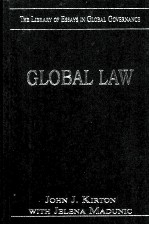
PART Ⅰ THE SOURCES AND DEVELOPMENT OF INTERNATIONAL LAW 3
1 Hans J.Morgenthau (1940), ‘Positivism, Functionalism, and International Law’,American Journal of International Law, 34, pp.260—84 3
2 Philip C.Jessup (1947), ‘The Subjects of a Modern Law of Nations’, Michigan Law Review, 45, pp.383—408 29
3 H.Lauterpacht (1955), ‘Codification and Development of International Law’,American Journal of International Law, 49, pp.16—43 55
4 Richard A.Falk (1967), ‘New Approaches to the Study of International Law’,American Journal of International Law, 61, pp.477—95 83
5 Myres S.McDougal and W.Michael Reisman (1980), ‘The Prescribing Function in World Constitutive Process: How International Law is Made’, Yale Studies in World Public Order, 6, pp.249—84 103
6 Ian Brownlie (1981), ‘The Reality and Efficacy of International Law’, British Yearbook of International Law, 52, pp.1—8 139
7 John H.Jackson (1998), ‘Global Economics and International Economic Law’,Journal of International Economic Law, 1, pp.1—23 147
PART ⅡCOMPETING THEORIES OF INTERNATIONAL LAW 173
8 William D.Coplin (1965), ‘International Law and Assumptions about the State System’, World Politics, 17, pp.615—34 173
9 Robert O.Keohane (1997), ‘International Relations and International Law: Two Optics’, Harvard International Law Journal, 38, pp.487—502 193
10 Christoph Schreuer (1993), ‘The Waning of the Sovereign State: Towards a New Paradigm for International Law?’, European Journal of International Law, 4,pp.447—71 209
11 Kenneth W.Abbott, Robert O.Keohane, Andrew Moravcsik, Anne-Marie Slaughter and Duncan Snidal (2000), ‘The Concept of Legalization’, International Organization, 54, pp.401—19 235
PART Ⅲ HARD LAW, SOFT LAW, LEGALIZATION AND NORMS 257
12 Kenneth W.Abbott and Duncan Snidal (2000), ‘Hard and Soft Law in International Govenance’, International Organization, 54, pp.421—56 257
13 Martha Finnemore and Stephen J. Toope (2001), ‘Alternatives to “Legalization”:Richer Views of Law and Politics’, International Organization, 55, pp. 743—58 293
14 Judith Goldstein and Lisa L. Martin (2000), ‘Legalization, Trade Liberalization,and Domestic Politics: A Cautionart Note’, International Organization, 54,pp. 603—32 309
15 Benedict Kingsbury(1998), ‘Sovereignty and Inequality’, European Journal of International Law, 9, pp. 599—625 339
16 Walter Mattli (2001), ‘Private Justice in a Global Economy: From Litigation to Arbitration’, International Organization, 55, pp. 919— 47 367
PART Ⅳ DOES INTERNATIONAL LAW MATTER? COMPLIANCE,LEGITIMACY AND ACCOUNTABILITY 399
17 Abram Chayes and Antonia Handler Chayes (1993), ‘On Compliance’,International Organization, 47, pp. 175—205 399
18 Andrew P. Cortell and James W. Davis, Jr (1996) ‘How do International Institutions Matter? The Domestic Impact of International Rules and Norms’,International Studies Quarterly, 40, pp. 451—78 431
19 Thomas M. Franck (2006) ‘The Power of Legitimacy and the Legitimacy of Power: International Law in an Age of Power Disequilibrium’, American Journal of International Law, 100, pp. 88—106 459
PART Ⅴ THE LAWS OF WAR AND FORCE 481
20 Richard Falk (1996), ‘The Complexities of Humanitarian Intervention: A New World Order Challenge’, Michigan Journal of International Law, 17, pp. 491—513 481
21 Thomas M. Franck (2003), ‘The Use of Force in International Law’, Tulane Journal o★ International and Comparative Law, 11, pp. 7—19 505
Name Index 519
